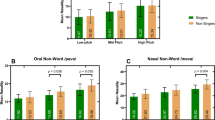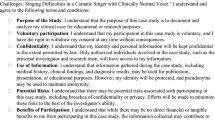Abstract
Purpose
The purpose of the present study was to compare the voice of choir singers before and after 60 min of singing and after an absolute rest.
Methods
Twenty-one female choir singers aged on average 26.59 years, with experience in choir singing of at least one year were instructed to emit the vowel /a/ before and after singing and after a vocal rest of 30 min for an analysis of acoustic measures, and for the evaluation of their tactile–kinesthetic self-perception. Vocal warm-up was performed for 10 min. The participants were instructed to sing the “Ave Verum” music continuously for 60 min.
Results
f0 (p = 0.0001) and Flo (p = 0.0002) increased after the singing test and were reduced after the vocal rest, in contrast to Fhi (p = 0.001), which continued to be increased compared to the pre-test measure even after the vocal rest. The vAm parameter (p = 0.05) was reduced after continuous singing and rest. All self-evaluation symptoms increased after the continuous singing task and were reduced after the 30 min rest, except for complaints of low voice, pain when swallowing and cough/throat clearing.
Conclusion
60 min of continuous use of the singing voice induced signs of vocal fatigue with an increase in f0, with improvement of symptoms and a reduction of f0 occurring after 30 min of vocal rest.
Similar content being viewed by others
References
Vilkman E (2004) Occupational safety and health aspects of voice and speech professions. Folia Phoniatr Logop 56:220–253
Smith B (2018) The art and science of lifelong singing. J Voice 32(3):291–299
Gish A, Kunduk M, Sims L, McWhorter AJ (2012) Vocal warm-up practices and perceptions in vocalists: a pilot survey. J Voice 26(1):e1–e10
Laukkanen AM, Järvinen K, Artkoski M, Waaramaa-Mäki-Kulmala T, Kankare E, Sippola S, Syrjä T, Salo A (2004) Changes in voice and subjective sensations during a 45-min vocal loading test in female subjects with vocal training. Folia Phoniatr Logop 56(6):335–346
Franca MC, Wagner JF (2015) Effects of vocal demands on voice performance of student singers. J Voice 29(3):324–332
Jilek C, Marienhagen J, Hacki T (2004) Vocal stability in functional dysphonic versus healthy voices at different times of voice loading. J Voice 18(4):443–453
Vintturi J, Alku P, Sala E, Sihvo M, Vilkman E (2003) Loading-related subjective symptoms during a vocal loading test with special reference to gender and some ergonomic factors. Folia Phoniatr Logop 55(2):55–69
Hunter EJ, Titze IR (2009) Quantifying vocal fatigue recovery: dynamic vocal recovery trajectories after a vocal loading exercise. Ann Otol Rhinol Laryngol 118(6):449–460
Solomon NP, DiMattia MS (2000) Effects of a vocally fatiguing task and systemic hydration on phonation threshold pressure. J Voice 14(3):341–362
Chang A, Karnell MP (2004) Perceived phonatory effort and phonation threshold pressure across a prolonged voice loading task: a study of vocal fatigue. J Voice 18:454–466
McHenry M, Evans J, Powitzky E (2016) Vocal assessment before, after and the day after opera performance. J Voice 30(2):186–191
Onofre F, Prado YA, Rojas GVE, Garcia DM, Aguiar-Ricz LN (2017) Measurements of the acoustic speaking voice after vocal warm-up and cooldown in choir singers. J Voice 31(1):129.e9–129.e14
- Aguiar-Ricz LN, Pellicani AD (2011) Psychometric instrument for the measurement and evaluation of auditory perception and tactile–kinesthetic vocal resistance. In: 1st Congress of the Confederation of European Otorhinolaryngology and Head and Neck Surgery. July; Barcelona, Spain, 2011, p. 448.
Pellicani AD, Ricz H, Iqueda APD, Aguiar-Ricz L (2017) Effect of the tracheoesophageal voice resistance test in total laryngectomees. Laryngoscope 127:405–410
Sander EK, Ripich DE (1983) Vocal fatigue. Ann Otol Rhinol Laryngol 92(2):141–145
Rantala L, Vilkman E, Bloigu R (2002) Voice changes during work: subjective complaints and objective measurements for female primary and secondary schoolteachers. J Voice 16(3):344–355
Pellicani AD, Ricz HM, Ricz LN (2015) Phonatory function after prolonged voice use in Brazilian women. Codas 27(4):392–399
Hunter EJ, Titze IR (2010) Variations in intensity, fundamental frequency, and voicing for teachers in occupational versus non-occupational settings. J Speech Lang Hear Res 53(4):862–875
Yiu EML et al (2011) Quantitative high-speed laryngoscopic analysis of vocal fold vibration in fatigued voice of young karaokê singers. J Voice 25(3):e115–e121
Schneider B, Bigenzahn W (2003) Influence of glottal closure configuration on vocal efficacy in young normal speaking woman. J Voice 14(4):468–480
Welham N, Maclagan MA (2004) Vocal fatigue in young trained singers across a solo performance: a preliminary study. Logoped Phoniatr Vocol 29(1):3–12
Buder EH, Wolf T (2003) Instrumental and perceptual evaluations of two related singers. J Voice 17(2):228–244
Whitling S, Rydell R, LybergÅhlander V (2015) Design of a clinical vocal loading test with long-time measurement of voice. J Voice 29(2):261.e13–27
Laukkanen AM, Kankare E (2006) Vocal loading-related changes in male teachers' voices investigated before and after a working day. Folia Phoniatr Logop 58(4):229–239
Amir O, Amor N, Michaeli O (2005) Evaluating the influence of warm up on singing voice quality using acoustic measures. J Voice 19(2):252–260
Boucher VJ, Ayad T (2010) Physiological attributes of vocal fatigue and their acoustic effects: a synthesis of findings for a criterion-based prevention of acquired voice disorders. J Voice 24(3):324–336
Vogel AP, Fletcher J, Maruff P (2010) Acoustic analysis of the effects of sustained wakefulness on speech. J Acoust Soc Am 128(6):3747–3756
Kwak PE, Stasney CR, Hathway JR, Guffey D, Minard CG, Ongkasuwan J (2017) Physiologic and acoustic effects of opera performance. J Voice 31(1):117.e11–117.e16
Boucher VJ (2008) Acoustic correlates of fatigue in laryngeal muscles: findings for a criterion-based prevention of acquired voice pathologies. J Speech Lang Hear Res 51(5):1161–1170
Carroll T, Nix J, Hunter E, Emerich K, Titze I, Abaza M (2006) Objective measurement of vocal fatigue in classically trained singers: a pilot study of vocal dosimetry data. Otolaryngol Head Neck Surg 135(4):595–602
Rantala L, Vilkman E (1999) Relationship between subjective voice complaints and acoustic parameters in female teachers' voices. J Voice 13(4):484–495
Laukkanen A-M, Ilomaki I, Leppanen K, Vilkman E (2008) Acoustic measures and self-reports of vocal fatigue by female teachers. J Voice 22:283–289
Funding
None.
Author information
Authors and Affiliations
Corresponding author
Ethics declarations
Conflict of interest
The authors declare that they have no conflict of interest.
Ethics approval
All procedures in studies involving human participants were in accordance with the ethical standards of the national research committee and with the 1964 Helsinki.Declaration and its later amendments. This study was approved by the Research Ethics Committee of the Clinics Hospital of the School of Medicine of Ribeirão Preto of the University of São Paulo according to protocol number 9711/2008.
Informed consent
Informed consent was obtained from all individual participants included in the study. Participants signed informed consent regarding publishing their data.
Additional information
Publisher's Note
Springer Nature remains neutral with regard to jurisdictional claims in published maps and institutional affiliations.
Rights and permissions
About this article
Cite this article
Onofre, F., Ricz, H., de Almeida Prado, Y. et al. Vocal resistance among choir singers. Eur Arch Otorhinolaryngol 278, 159–165 (2021). https://doi.org/10.1007/s00405-020-06238-7
Received:
Accepted:
Published:
Issue Date:
DOI: https://doi.org/10.1007/s00405-020-06238-7




